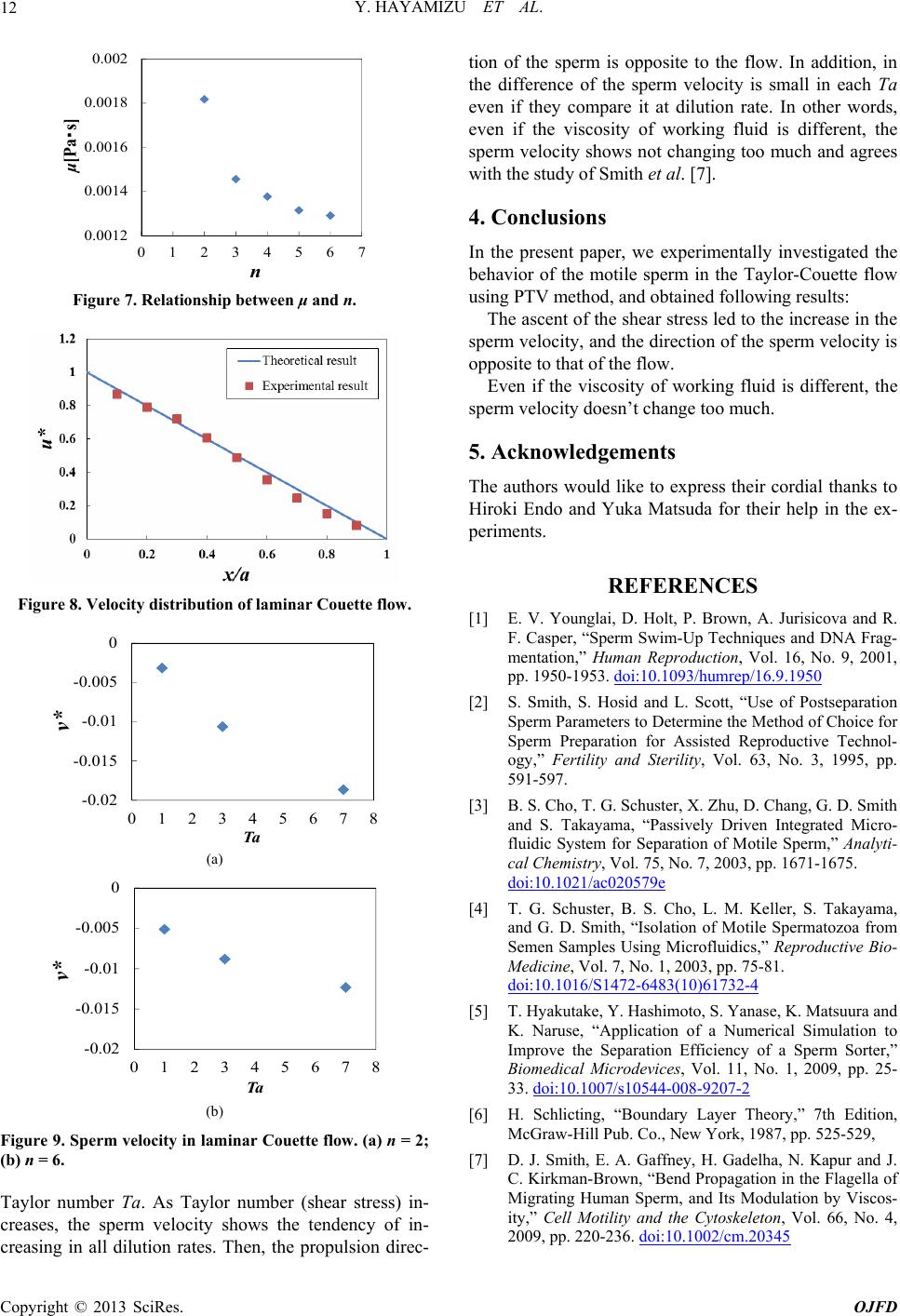
Y. HAYAMIZU ET AL.
12
0.0012
0.0014
0.0016
0.0018
0.002
01234567
μ[Pa・s]
n
Figure 7. Relationship between μ and n.
Figure 8. Velocity distribution of laminar Couette flow.
-0.02
-0.015
-0.01
-0.005
0
012345678
v*
Ta
(a)
-0.02
-0.015
-0.01
-0.005
0
012345678
v*
Ta
(b)
Figure 9. Sperm velocity in laminar Couette flow. (a) n = 2;
(b) n = 6.
Taylor number Ta. As Taylor number (shear stress) in-
creases, the sperm velocity shows the tendency of in-
creasing in all dilution rates. Then, the propulsion direc-
tion of the sperm is opposite to the flow. In addition, in
the difference of the sperm velocity is small in each Ta
even if they compare it at dilution rate. In other words,
even if the viscosity of working fluid is different, the
sperm velocity shows not changing too much and agrees
with the study of Smith et al. [7].
4. Conclusions
In the present paper, we experimentally investigated the
behavior of the motile sperm in the Taylor-Couette flow
using PTV method, and obtained following results:
The ascent of the shear stress led to the increase in the
sperm velocity, and the direction of the sperm velocity is
opposite to that of the flow.
Even if the viscosity of working fluid is different, the
sperm velocity doesn’t change too much.
5. Acknowledgements
The authors would like to express their cordial thanks to
Hiroki Endo and Yuka Matsuda for their help in the ex-
periments.
REFERENCES
[1] E. V. Younglai, D. Holt, P. Brown, A. Jurisicova and R.
F. Casper, “Sperm Swim-Up Techniques and DNA Frag-
mentation,” Human Reproduction, Vol. 16, No. 9, 2001,
pp. 1950-1953. doi:10.1093/humrep/16.9.1950
[2] S. Smith, S. Hosid and L. Scott, “Use of Postseparation
Sperm Parameters to Determine the Method of Choice for
Sperm Preparation for Assisted Reproductive Technol-
ogy,” Fertility and Sterility, Vol. 63, No. 3, 1995, pp.
591-597.
[3] B. S. Cho, T. G. Schuster, X. Zhu, D. Chang, G. D. Smith
and S. Takayama, “Passively Driven Integrated Micro-
fluidic System for Separation of Motile Sperm,” Analyti-
cal Chemistry, Vol. 75, No. 7, 2003, pp. 1671-1675.
doi:10.1021/ac020579e
[4] T. G. Schuster, B. S. Cho, L. M. Keller, S. Takayama,
and G. D. Smith, “Isolation of Motile Spermatozoa from
Semen Samples Using Microfluidics,” Reproductive Bio-
Medicine, Vol. 7, No. 1, 2003, pp. 75-81.
doi:10.1016/S1472-6483(10)61732-4
[5] T. Hyakutake, Y. Hashimoto, S. Yanase, K. Matsuura and
K. Naruse, “Application of a Numerical Simulation to
Improve the Separation Efficiency of a Sperm Sorter,”
Biomedical Microdevices, Vol. 11, No. 1, 2009, pp. 25-
33. doi:10.1007/s10544-008-9207-2
[6] H. Schlicting, “Boundary Layer Theory,” 7th Edition,
McGraw-Hill Pub. Co., New York, 1987, pp. 525-529,
[7] D. J. Smith, E. A. Gaffney, H. Gadelha, N. Kapur and J.
C. Kirkman-Brown, “Bend Propagation in the Flagella of
Migrating Human Sperm, and Its Modulation by Viscos-
ity,” Cell Motility and the Cytoskeleton, Vol. 66, No. 4,
2009, pp. 220-236. doi:10.1002/cm.20345
Copyright © 2013 SciRes. OJFD